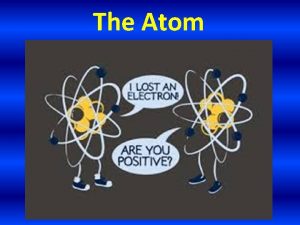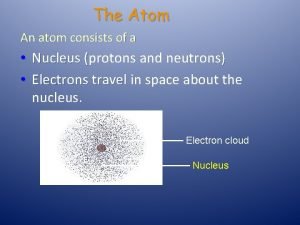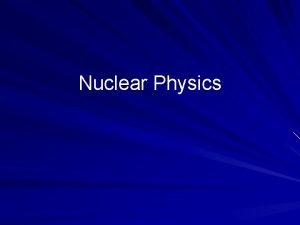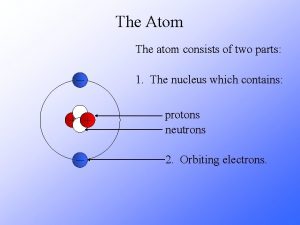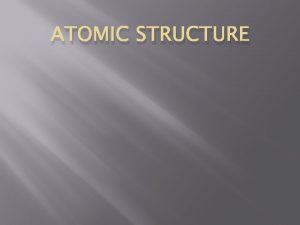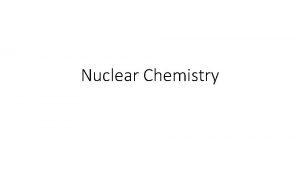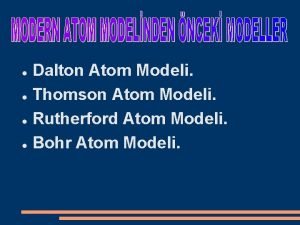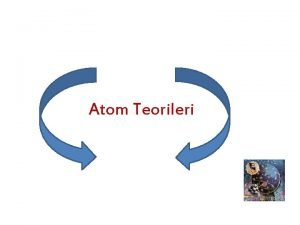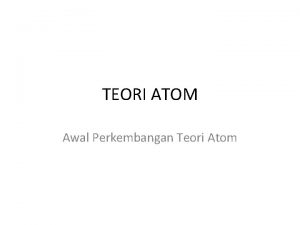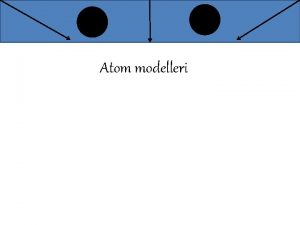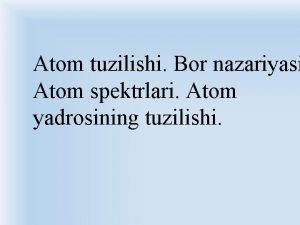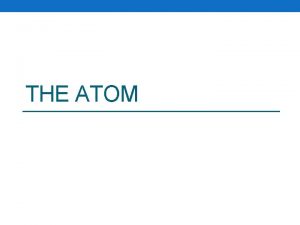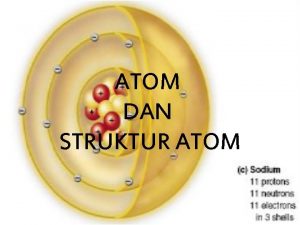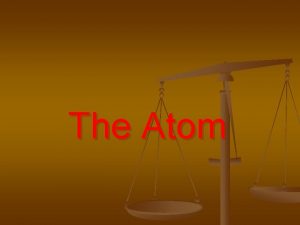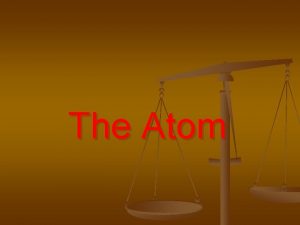RutherfordPlanetaryNuclear Model of atom the atom consists of

































- Slides: 33



Rutherford/Planetary/Nuclear Model of atom: the atom consists of a very tiny but very massive positive nucleus, surrounded by electrons that orbit the nucleus as result of electrostatic attraction between the electrons and the nucleus evidence: Geiger and Marsden’s experiment: • Alpha particles bombarded at a sheet of gold foil mostly passed through—atoms mostly consist of empty space. • Particles that were deflected bounced straight back from the foil—the huge deflection of the alpha particles must have been caused by electrostatic repulsions between the positive alpha particles and a dense, positive nucleus. limitations/problems: • Electrons are orbiting nucleus, therefore changing direction, and therefore accelerating • According to Maxwell, any accelerating charge will generate an EM wave • This EM wave would be a release of energy and give off light at all sorts of wavelengths. • electron releasing energy should slow down and eventually spiral into the nucleus.

Bohr’s Model: • Electrons orbit at specific energy levels (“discrete states”), called “stationary states. ” – we say energy is quantized • Electrons in these stationary states do not emit EM waves as they orbit. • Photon must be first absorbed in order to be emitted. Absorbed photon has the energy equal to the difference between excited and ground state. • Photon is emitted when an electron jumps from excited state to a lower energy state. Energy of that photon is equal to the energy difference between two states. E photon = ΔE, and frequency is given by Einstein’s relationship between energy and frequency of a photon: E = hf h = Planck's constant = 6. 627 x 10 -34 Js Problems with Bohr’s Model: It worked only for hydrogen atom Modern approach - Schrodinger wave function: • energy level model - give possible energies of electrons and probability to find electrons somewhere is given by wave function.

Bohr’s Model - atomic energy levels ▪ Electrons could only exist in certain orbits at specific energy levels (“discrete states”), called “stationary states. ” ▪ n is called the principal quantum number and goes all the way up to infinity ( )! ▪ Electrons in these stationary states do not emit EM waves as they orbit. ▪ If a photon of just the right energy strikes an atom, it is absorbed by the atom causing an electron to jump to a higher energy level: ▪ We say the atom is excited ▪ Electron stays in higher energy level only for about 1 ns. emitted/absorbed photon has: ▪ When the atom de-excites the electron jumps back to a lower energy level Thinkquest http: //library. thinkquest. org/16468/gather/english. htm

These energies naturally lead to the explanation of the hydrogen atom spectrum: Transitions between energy levels ▪ In its ground state or unexcited state, hydrogen’s single electron is in the 1 st energy level (n = 1): excitation de-excitation Energy of that photon is equal to the energy difference between two states. Ephoton = ΔE Albert Einstein: The frequency of emitted light (photon) is proportional to the change of energy of the electron:

▪ A hot solid, liquid or gas at high pressure produces a continuous spectrum: all λ. ▪ A continuous spectrum source viewed through a cool, low-density gas produces an absorption-line spectrum – missing λ – dark lines. ▪ A hot, low-density / low pressure gas produces an emission-line spectrum: only specific λ. continuous spectrum light source compare… absorption spectrum cool gas emission spectrum hot gas Same fingerprint! Thus when we see a spectrum we can tell what source we are seeing.

Continuous Spectrum (without prism white light) • a spectrum having all wavelengths over a comparatively wide range • All possible frequencies of EM waves are present. • Generally, solids, liquids, or high pressured (dense) gases emit a continuous spectrum when heated. BTR • Generally, strong interaction between molecules (spreading energy band) Discrete/ Line spectrum - Evidence of electron energy levels Pattern of distinct lines of color, corresponding to particular wavelengths. Generally, weak or no interaction between molecules (no spreading of energy band) BTR • Emission Spectrum • Set of frequencies of the electromagnetic waves emitted by atoms of a particular element. • A hot, low-density / low pressure gas (gas in the atomic state) produces an emission-line spectrum – energy only at specific λ. • Absorption Spectrum • Pattern of dark lines against a continuous spectrum background that results from the absorption of selected frequencies by an atom or molecule. • An absorption spectrum occurs when light passes through a cold, dilute gas and atoms in the gas absorb at characteristic frequencies; since the re-emitted light is unlikely to be emitted in the same direction as the absorbed photon, this gives rise to dark lines (absence of light) in the spectrum.

Nucleon: Nucleon a proton or neutron. Nuclide: Nuclide A particular combination of protons and neutrons that form a nucleus. It is used to distinguish isotopes among nuclei. • • X is chemical symbol of the element Z is the atomic number = number of electrons or protons A is the nucleon (mass) number = number of neutrons + protons A – Z = number of neutrons Isotopes: Isotopes Nuclides contains the same number of protons but different number of neutrons. Isotopes are evidence for the existence of neutrons. Repulsive electromagnetic forces between the protons would cause the nucleus to disintegrate if it were the only force. Strong nuclear force is an attractive force, which exists between all nucleons to hold them together. It is effective only over a very short range (10 -15 m). Nuclear Stability: Stability depends on the neutron-proton ratio Nuclei are held together by a strong nuclear force, which counteracts the repulsive force among protons contained within it. As long as the attractive nuclear forces between all nucleons win over the repulsive Coulomb forces between the protons the nucleus is stable. It happens as long as the number of protons is not too high. Atomic nuclei are stable subject to the condition that they contain an adequate number of neutrons, in order to "dilute" the concentration of positive charges ♦ Small nuclei- tend to have equal number of neutrons and protons ♦ Large nuclei- tend to have more neutrons to counterbalance repulsive Coulomb force. The most massive isotope found in nature is uranium isotope For more massive nuclei strong nuclear force can’t overcome electric repulsion.

Feynman diagram for β − decay: caused by the conversion of the down quark (− 1/3 e) to the up quark (+2/3 e) by emission of a W− boson; the W − boson subsequently decays into an electron and an electron antineutrino: However, β+ decay cannot occur in an isolated proton because it requires energy due to the mass of the neutron being greater than the mass of the proton. β+ decay can only happen inside nuclei when the daughter nucleus has a greater binding energy (and therefore a lower total energy) than the mother nucleus. The difference between these energies goes into the reaction of converting a proton into a neutron, a positron and a neutrino and into the kinetic energy of these particles. In an opposite process to negative beta decay, the weak interaction converts a proton into a neutron by converting an up quark into a down quark by having it emit a W+ or absorb a W−.

Fundamental forces and their properties STRONG ELECTRO-WEAK ELECTROMAGNETIC WEAK GRAVITY + + nuclear light, heat and force charge STRONGEST Range: Extremely Short Force Carrier: Gluon radioactivity Range: Force Carrier: Photon Range: Short freefall WEAKEST Range: Force Carrier: Graviton

Stability & Radioactive decay • If you plot the neutron number N against the proton number Z for all the known nuclides, you get the diagram shown here ▪Stable isotopes exist for elements having atomic numbers Z = 1 to 83. ▪ Up to Z = 20, the neutron-to- proton ratio is close to 1. ▪ Beyond Z = 20, the neutron-to-proton ratio is bigger than 1, and grows with atomic number. ▪ The extra neutrons counteract the repulsive Coulomb force between protons by increasing the strong force but not contributing to the Coulomb force. ▪ It is the strong nuclear force that holds the nucleons together, but this is a very short range force. ▪ The repulsive electric force between the protons is a longer range force. ▪ So in a large nucleus all the protons repel each other, but each nucleon attracts only its nearest neighbours. More neutrons are needed to hold the nucleus together (although adding too many neutrons can also cause instability). There is an upper limit to the size of a stable nucleus; all the nuclides with Z higher than 83 are unstable.

Radioactive Decay Spontaneous decay of unstable nuclei. • process in which unstable nucleus loses energy by emitting “radiation” in form of particles or EM waves, resulting in transformation of parent nuclide into daughter nuclide. • three common radiations - alpha, beta, gamma • they differ in charge, ionization and penetration power. Alpha decay: 4 He or 4 a 2 2 • nucleus ejects an α particle, the atomic number is decreased by two and the atomic mass is decreased by four • charge is + 2 e • the most ionizing and therefore the least penetrating (a few cm of air) • Governed by strong nuclear force = α decay occurs primarily among heavy elements because the nucleus has too many protons which cause excessive repulsion. In an attempt to reduce the repulsion, a helium nucleus is emitted. Mass of parent > mass of daughter + mass of alpha • difference = kinetic energy Beta decay ● Beta particles are high energy electrons emmited from the nuclus • nucleus spontaneously emits beta particle and an antineutrino • In β− decay, the weak interaction converts a neutron into a proton while emitting an electron and an anti-neutrino: • the most common decay occurs when the neutron to proton ratio is too great in the nucleus and causes instability • charge is – e • medium ionizing and therefore medium penetrating (a few mm of metal)

▪ In + decay, a proton becomes a neutron and a positron is emitted from the nucleus. ▪ This means that the proton number decreases by 1, while the total nucleon number remains the same. 10 C 10 B + + e+ In contrast to the alpha particle, it was discovered that beta particles could have a large variety of kinetic energies. Gamma Decay • EM waves (high-energy photons) are emitted from a nucleus in an excited state dropping to a lower energy state (more stable) • charge is 0 • no ionizing and therefore highly penetrating (a few cm of lead or thick concrete can reasonably protect) Biological effects of ionizing radiation • Prompt effects: effects, including radiation sickness and radiation burns, seen immediately after large doses of radiation delivered over short periods of time. • Delayed effects: effects such as cataract formation and cancer induction that may appear months or years after a radiation exposure

Half – life T 1 /2 is the interval of time required for one-half of the atomic nuclei of a radioactive sample to decay. Activity (becquerel - Bq) of a radioactive sample is the average number of disintegrations per second. Exponential Decay • Any quantity that reduces by the same fraction in the same period of time will follow an exponential decay curve. • The half life can be calculated from decay curves • Take several values and the take an average

Nuclear Reactions – A reaction that occurs whenever the number of protons or neutrons changes. Nuclear reactions include natural and artificial transmutation, fission, and fusion. Transmutation – Change of one element into another. In natural transmutations the nucleus decays spontaneously. There is only one nucleus that undergoes the transformation. Artificial transmutation is induced by the bombardment of the nucleus by high-energy particles (Uranium atoms bombarded with neutrons to start fission reaction. ) In order to balance nuclear reaction the total mass/energy and total charge number of the reactants has to equal the total mass/energy and total charge number of the products.

Unified Atomic Mass Unit (u) is 1/12 of the mass of one atom of carbon-12 atom (6 p+6 n+6 e) • 1 u = 1. 66056655 x 10 -27 kg • 1 u of mass converts into 931. 5 Me. V • 1 u = 931. 5 Me. V c-2 due to relationship E = mc 2 The "mass defect" is therefore mass that transforms to energy according to Einstein's equation and is released in forming the nucleus from its component particles. ▪ Binding energy (BE) - is the energy required to separate the nucleus into it individual nucleons / the energy that is released in assembling a nucleus from its individual nucleons. (heat, light, higher energy states of the nucleus …). nuclear binding energy is actually energy that corresponds to mass defect 1. BE in Me. V: • find mass defect in u and multiply it by 931. 5 Me. V 2. ME in J: • BE = ∆m c 2 (c = 3 x 108 m/s, ∆m = mass defect in kg)

Energy released/required in a nuclear reaction/artificial transmutation Nuclear reactions A + B → C + D can either release energy or requires energy input. • release energy: Energy will be released in nuclear reaction if Δm = LHS – RHS > 0 The total amount of energy released will be in the form of kinetic energy of products. If there was initial kinetic energy, that will be added up to released energy released in nuclear reaction is found the same way as binding energy: first find mass difference and then equivalent energy Δm in u, E = (Δm) x 931. 5 (Me. V) or Δm in kg, E = (Δm) c 2 (J) • energy input: if Δm = LHS – RHS < 0, reaction cannot be spontaneous. For example, some nuclei will decay only if energy is supplied to it - collision with fast moving α particle: α particle must have enough KE to make up for imbalance in masses, and to provide for kinetic energy of products. Energy released in a decay - conservation of total energy (energy + mass). as always M > m 1 + m 2 , but total energy on the left = total energy on the right Mc 2 = m 1 c 2 + m 2 c 2 + KE 1 + KE 2 • spontaneous decay: M > m 1 + m 2 → binding energy of the decaying nucleus < binding energies of the product nuclei. This is why radioactive decay happens with heavy elements lying to the right of maximum in the binding energy curve. Energy released is in the form of kinetic energy of the products.

Binding energy per nucleon: nucleon the work required to remove one nucleon from the nucleus; roughly the binding energy divided by the total number of nucleons in nucleus. The binding energy of a nucleus is a measure of how stable nucleus is. Greater mass defect – higher binding energy – greater stability. Most nuclei have a binding energy per nucleon of approximately 8 Me. V. Nuclear fission: process in which a large nucleus (A>200) splits up into two smaller nuclei, generally accompanied by the release of one or more neutrons and energy (as gamma rays and as kinetic energy of the fragments). Large amounts of energy produced, can be selfsustaining due to chain reactions. The total BE would increase which means that the daughters are more stable than parent. Spontaneous fission is very rare. Nuclear fusion: fusion joining of two small nuclei into a bigger one, releasing great amounts of energy in the process. High temperatures are required to provide sufficient kinetic energy to approach each other, overcoming electrostatic repulsion. When two small nuclei the product of fusion would have more BE per nucleon. The increases in binding energy per nucleon are much larger for fusion than for fission reactions, because the graph increases more steeply for small nuclei, so fusion gives out more energy per nucleon than fission.

proton is uud neutron is udd S = # antistrange quarks – # strange quarks The mass of the gauge boson/exchange particles establishes the range of the force. Exchange particles whose range of influence is limited are called virtual particles. Virtual particles can only exist within their range of influence.

Description and classification of particles ▪ An elementary particle has no internal structure. ▪The force carriers/gauge bosons are the particles that allow compatible particles to sense and react to each other’s presence through exchange of these carriers. ▪The quarks are the heavier, tightly bound particles that make up particles like protons and neutrons. ▪The leptons are the lighter, more loosely bound particles like electrons.

Fundamental forces and their properties STRONG ELECTRO-WEAK ELECTROMAGNETIC WEAK STRONGEST Range: Extremely Short WEAKEST 1. 0 Range: Short Range: Force Carrier: Photon Force Carrier: Gluon relative strength GRAVITY 0. 01 0. 000001 Range: Force Carrier: Graviton 10 -39

The nature and range of the force carriers ▪ In 1933 Hideki Yukawa developed theory of exchange forces. ▪ The basic idea is that all forces are due to the exchange of particles between like elementary particles. ▪ Consider two protons in space. ▪ Yukawa postulated that the protons exchange photons and repel each other because of this exchange. ▪ This photon exchange is the electromagnetic force. ▪ Yukawa explained that the electromagnetic force was long range (in fact infinite in range) because photons "live forever" until they are absorbed. ▪ Yukawa explained that the strong force was short range (in fact only in the nuclear range) because the strong force exchange particle (the gluon) has a very short life. LONG RANGE EXCHANGE PARTICLE SHORT RANGE EXCHANGE (VIRTUAL) PARTICLE

The nature and range of the force carriers Exchange particles whose range of influence is limited are called virtual particles. The four fundamental forces have different ranges and a different gauge boson is responsible for each force. The mass of the boson establishes the range of the force. The bosons carry the force between particles. Virtual particles can only exist within their range of influence.

Quarks and their antiparticles In 1964 the particle model was looking quite complex and unsatisfying. Murray Gell-Mann proposed a model where all the strong-force particles were made up of three fundamental particles called quarks. Every particle has an antiparticle which has the same mass but all of its quantum numbers are the opposite. Thus an antiproton (p) has the same mass as a proton (p), but the opposite charge (-1). When matter meets antimatter both annihilate each other to become energy! proton is uud neutron is udd proton u d u

NEW STANDARD MODEL of ELEMENTARY PARTICLES By Miss. MJ - Own work by uploader, PBS NOVA [1], Fermilab, Office of Science, United States Department of Energy, Particle Data Group, CC BY 3. 0, https: //commons. wikimedia. org/w/index. php? curid=4286964

Conservation of strangeness ▪ The strangeness number S of a baryon is related to the number of strange quarks the particle has. S = # antistrange quarks – # strange quarks EXAMPLE: The lambda zero particle ( 0) is a baryon having the quark combo of (uds). What is its charge? What is its strangeness? From the table the charges are u = +2/3, d = -1/3 and s = -1/3 so that the total charge is 0. S = # antistrange quarks – # strange quarks = 0 – 1 = -1.

Conservation of strangeness The – is a hadron because it is composed of quarks. The proton is composed of uud If X is sss, then the reaction can be written su + uud ds + us + sss. The left has an s, u, and d left. The right also has an s, u, and d left. The quarks are balanced on each side.

conservation rules in reactions ▪ charge is conserved ▪ baryon number is conserved ▪ lepton number is conserved ▪ strangeness is conserved ▪ Quark confinement means that we cannot ever separate a single quark from a baryon or a meson. ▪ Because of the nature of the strong force holding the quarks together we need to provide an energy that is proportional to the separation. ▪ Eventually, that energy is so vast that a new quark-antiquark pair forms and all we have is a meson, instead of an isolated quark!


Feynman diagrams Particles are represented with straight arrows. Exchange (force) particles are represented with either wavy lines (photons, W+, W- and Z 0), or curly lines (gluons). In a Feynman diagram, antimatter points backward in time. repulsion of two electrons two positrons repelling each other electron emitting a photon positron emitting a photon

photon producing an electron-positron pair annihilating to become a photon down quark emitting a W- particle that decays into an electron and an antineutrino The up quark of a proton (uud) emits a gluon. The gluon decays into a down quark and an anti-down quark, which quickly annihilate - decay

 Perkembangan model atom
Perkembangan model atom The structure of the atom section 2 defining the atom
The structure of the atom section 2 defining the atom Hình ảnh bộ gõ cơ thể búng tay
Hình ảnh bộ gõ cơ thể búng tay Bổ thể
Bổ thể Tỉ lệ cơ thể trẻ em
Tỉ lệ cơ thể trẻ em Voi kéo gỗ như thế nào
Voi kéo gỗ như thế nào Glasgow thang điểm
Glasgow thang điểm Hát lên người ơi alleluia
Hát lên người ơi alleluia Môn thể thao bắt đầu bằng từ chạy
Môn thể thao bắt đầu bằng từ chạy Thế nào là hệ số cao nhất
Thế nào là hệ số cao nhất Các châu lục và đại dương trên thế giới
Các châu lục và đại dương trên thế giới Công của trọng lực
Công của trọng lực Trời xanh đây là của chúng ta thể thơ
Trời xanh đây là của chúng ta thể thơ Cách giải mật thư tọa độ
Cách giải mật thư tọa độ Làm thế nào để 102-1=99
Làm thế nào để 102-1=99 Phản ứng thế ankan
Phản ứng thế ankan Các châu lục và đại dương trên thế giới
Các châu lục và đại dương trên thế giới Thể thơ truyền thống
Thể thơ truyền thống Quá trình desamine hóa có thể tạo ra
Quá trình desamine hóa có thể tạo ra Một số thể thơ truyền thống
Một số thể thơ truyền thống Cái miệng nó xinh thế
Cái miệng nó xinh thế Vẽ hình chiếu vuông góc của vật thể sau
Vẽ hình chiếu vuông góc của vật thể sau Nguyên nhân của sự mỏi cơ sinh 8
Nguyên nhân của sự mỏi cơ sinh 8 đặc điểm cơ thể của người tối cổ
đặc điểm cơ thể của người tối cổ Thế nào là giọng cùng tên
Thế nào là giọng cùng tên Vẽ hình chiếu đứng bằng cạnh của vật thể
Vẽ hình chiếu đứng bằng cạnh của vật thể Tia chieu sa te
Tia chieu sa te Thẻ vin
Thẻ vin đại từ thay thế
đại từ thay thế điện thế nghỉ
điện thế nghỉ Tư thế ngồi viết
Tư thế ngồi viết Diễn thế sinh thái là
Diễn thế sinh thái là Dot
Dot






































